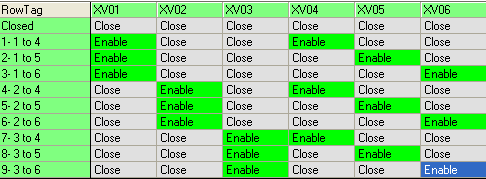Looking first at a relatively simple case where any of three tanks can transfer to any of three destinations via a single line.
I have seen implementations where this kind of transfer was programmed into the Source and Destination units only, however that approach gets more complex the more routes there are and requires extensive work defining and programming the logic.
This can however be reduced so each Unit only has a single transfer to define and only a single program module.
In this case the source tank is just called Tank src with it's discharge valve call XVSrv, likewise the destination is named dst. This can then apply to any of the 6 possible transfers
Now we can have a single and simple transfer out sequence (an S88 phase in the source unit) which opens the discharge valve XVsrc and a corresponding transfer in which opens the fill valve XVSrc. These phases do not need to worry about controlling the other valves in the route. In fact they don't care what the route is.
Of course there is more to it than that, as we still need to make sure that the other discharge valves and feed valves are closed.
How can we handle that?
Well, let's look at what the Line can do if we give it some intelligence
We could make it respond to a request for a route, in this can one of the 6 possible routes.
Then we can make sure that the valves that must be closed are closed and those that are to be opened (by the source and destination,) are Enabled, meaning that the relevant tank has control and can open or close the valve. Here is a table showing what the 'Line' logic does
Note - it may even be possible for the Line module to find the route by some logic that works it out itself, but a simple table works in cases like this.
Here we are in S88 terms
And we also need to establish some communications between the source and destination unit.
This can also be done by the 'Line' common resource. There will be more to come




1 comment:
You've explained the valve logic succinctly, but how are the tank phases defined and controlled?
Post a Comment